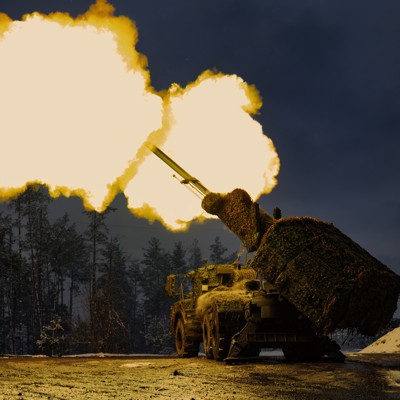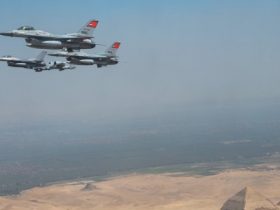An Army plan to modernize its artillery could include howitzers fielded in Europe, automated cannons, and long-range mortars, Army Futures Command chief Gen. James Rainey suggested Thursday at a Senate hearing Thursday.
“There are some very good wheeled howitzers that are having great effect in a place like Europe,” said Rainey, speaking while describing acquisition plans informed by an Army study on artillery modernization, also dubbed the tactical fires study.
The U.S. is planning on a competition between various mobile artillery systems this summer to select a new self-propelled howitzer. The competition follows the cancellation of the Extended Range Cannon Artillery (ERCA) howitzer.
Rainey may have been referring to artillery systems fielded in Ukraine, the only place in Europe where wheeled howitzers are being used in combat.
Ukraine uses a number of wheeled howitzers, including France’s Caesar, Sweden’s Archer, and the domestically produced 2S22 Bohdana. The Caesar has performed well on the battlefield, with losses of less than 10 percent amid frequent Russian drone strikes on Ukrainian artillery.
Rainey’s emphasis on mobile artillery comes following previous statements that artillery systems must constantly be on the move in order to avoid being identified and destroyed.
His interest in wheeled artillery marks a shift from the Army’s traditional focus on tracked howitzers like the Paladin. In 2021, the Army launched ultimately unsuccessful trials of various foreign wheeled artillery to pick one for its Stryker brigades.
Rainey also said the Army is also working on extending the range of mortar systems, and that the Army has seen success with one of three mortar calibers in use. The Army uses 60mm, 81mm, and 120mm mortars.
“We’re having great success with one of [of the mortars] and we’re going to expand that extended range and lethality efforts to the other ones,” Rainey said.
The efforts parallel Army work in developing longer-range howitzer rounds. In one test, BAE installed an extra-long Rheinmetall barrel on the Army’s standard Paladin howitzer to fire a modified 155mm round farther than ever before.
Echoing earlier comments made at the AUSA conference in March, Rainey also expressed interested in a “very capable autonomous and robotic cannon” made by a U.S. partner.
While Rainey did not specify which cannon he was referring to, U.S. allies Germany and Sweden allies have produced the RCH 155 and Archer, whose loading processes are automated. The RCH 155 may be able to drive autonomously in the future, according to a KNDS fact sheet.
Rainey also downplayed the importance of precision munitions for tactical fires, a term that refers to the use of indirect weapons in support of local objectives, such as silencing an enemy’s heavy artillery.
“Capability is nice, but unlike precision munitions where it’s sinking a handful of ships or closing a piece of ground, the most important thing in tactical fires is not just capability but its capacity,” he said, giving the example of blanketing an enemy formation with dozens of standard 155mm rounds versus destroying a tank with rounds costing hundreds of thousands of dollars.
Read the full article here


:quality(70)/cloudfront-us-east-1.images.arcpublishing.com/archetype/NZU25GOMX5BY3LLFX7PUC23FSA.jpg)

:quality(70)/cloudfront-us-east-1.images.arcpublishing.com/archetype/S4EGEYTSEJDDLDLJSZONQCZC6Y.jpg)

:quality(70)/cloudfront-us-east-1.images.arcpublishing.com/archetype/JS4NYOKBN5BGVEUNSA6W67V574.jpg)
Leave a Reply